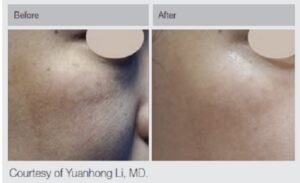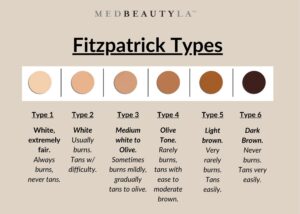IPL Alternatives For Dark Skin – Los Angeles

Seeking out IPL alternatives for dark skin in Los Angeles? MedBeautyLA’s team of experienced, diverse providers is here to help. Read on to get the 411 on the best non-IPL option for melanin-rich skin.
IPL, or intense pulsed light, is often considered the “holy grail” treatment for brown spots and hyperpigmentation. The problem? IPL isn’t always safe for darker, melanin-rich skin types, as it can result in even more hyperpigmentation. The good news? A safe and effective IPL alternative for dark skin does exist. It’s called the Q-switched laser (the Q-switched nd: yag laser if we want to get technical) and you should absolutely look into it if you are Fitzpatrick type 5 or 6 and struggling with dark spots.

Handy Fitzpatrick guide for your reference:

Firstly, Why Is IPL Not Good For Melanin-Rich Skin?
To understand the benefits of the Q-switched laser, it helps to know a little about why IPL isn’t the best course of treatment for darker skin. Traditional IPL works by targeting dark spots and breaking them up through bursts of light. But when the overall skin tone is melanin-rich, or dark, there is not enough contrast for the device to properly target just the hyperpigmented area. This can result in over-treatment and damage to the surrounding skin.
Why Q-Switched Laser Is the Go-To IPL Alternative For Dark Skin
Q-switched lasers use extremely selective targeting to reach dark pigment under the skin without affecting the outer layers. Additionally, the laser pulses are very short (nanoseconds, in fact), which reduces time for heat to accumulate. This minimizes the risk of overheating the skin and causing unwanted side effects like post-inflammatory hyperpigmentation (PIH), which is a common concern for melanin-rich skin.
The laser also uses lower energy levels as compared to IPL, making treatment much gentler on darker skin tones. This helps to further reduce the risk of adverse effects.
Additional Benefits of the Q-Switched Laser
Improved Skin Tone and Texture
In addition to treating hyperpigmentation, Q-switched laser treatments can help improve overall skin tone and texture. The laser stimulates collagen production, which can result in smoother, firmer skin over time. For individuals with melanin-rich skin, this can be particularly beneficial for addressing concerns such as rough texture, enlarged pores, and uneven tone without risking further pigmentation issues.
Safe For Treating Various Other Skin Concerns
The versatility of the Q-switched laser makes it suitable for addressing a wide range of skin issues that affect melanin-rich skin. Whether you’re looking to treat age spots, acne scars, or even melasma, Q-switched laser treatments can provide noticeable results. And again, it does this without the increased risk of PIH.
Minimal Downtime
Unlike more invasive skin treatments, Q-switched laser treatments typically involve little-to-no downtime. While some individuals may experience slight redness or swelling immediately following treatment, this usually subsides within a few hours. For people with melanin-rich skin, this is an added benefit because it reduces the risk of prolonged irritation or post-inflammatory hyperpigmentation that could arise from more invasive treatments.
Improves Overall Skin Health
Beyond its cosmetic benefits, the Q-switched laser contributes to overall skin health. By stimulating collagen production and promoting cellular turnover, the treatment encourages the skin to repair itself from within. This can lead to healthier, more resilient skin in the long term, reducing the likelihood of future skin issues.
Q-Switched Laser FAQs
How Many Q-Switched Laser Treatments Will I Need?
This depends on your specific skin concern. For hyperpigmentation — aka brown spots — most clients will require between 6-9 sessions spaced about 4 weeks apart. For general overall health and pore reduction, many clients come in every 6-8 weeks year-round.
Are Results Permanent?
Most patients will require re-treatment every few years in order to maintain results. However, wearing a daily SPF and maintaining proper sun safety will increase the time required between treatments.
What Is Considered “Dark” Skin When Discussing IPL?
For the purposes IPL specifically, Fitzpatrick type 6 is considered unsafe for treatment. However, your provider may also opt for an IPL alternative if you are Fitzpatrick type 5. This is why a pre-treatment consultation is important.
Are There Special Instructions After I Get My Q-Switched Treatment?
Yes! After treatment, it’s crucial to follow proper aftercare guidelines, including using sunscreen to protect your skin from UV damage, which can trigger new pigmentation issues. Additionally, avoid harsh skincare products that could irritate the skin in the days following your treatment.
Other IPL Alternatives For Dark Skin
Chemical peels can also provide an excellent solution for hyperpigmentation on higher Fitzpatrick types. However, many clients do not want the longer downtime and peeling/flaking that a chemical peel entails. We recommend talking to your provider about the pros and cons of both options.
The Importance Of Choosing The Right Provider

The MedBeautyLA Team
The reality is, not every office will have experience treating your specific skin type. This is why it’s incredibly important to select a provider who understands the specific needs of melanin-rich skin. A board-certified dermatologist or laser specialist will be able to assess your skin type and customize the treatment to minimize risks and maximize results.

